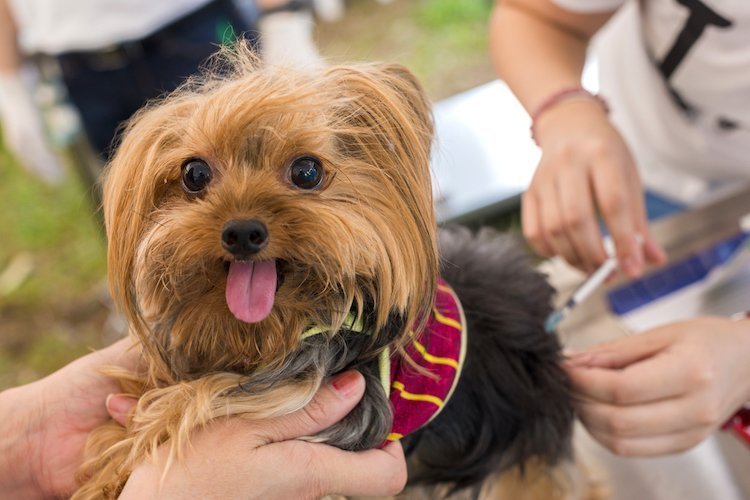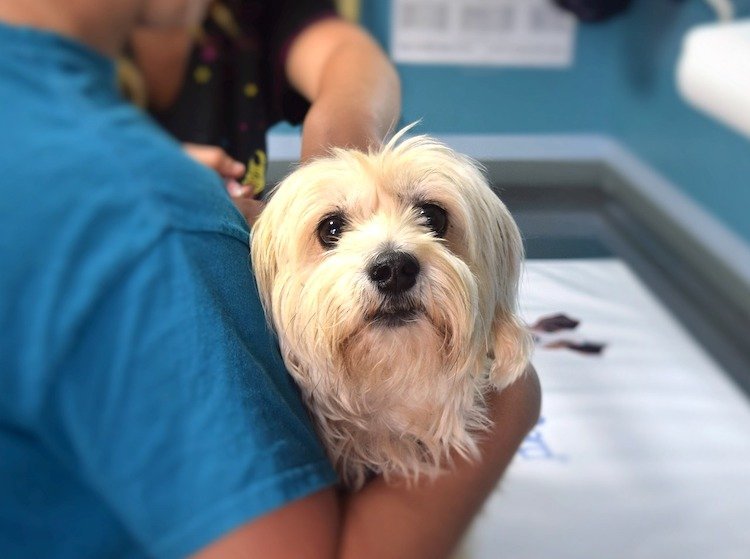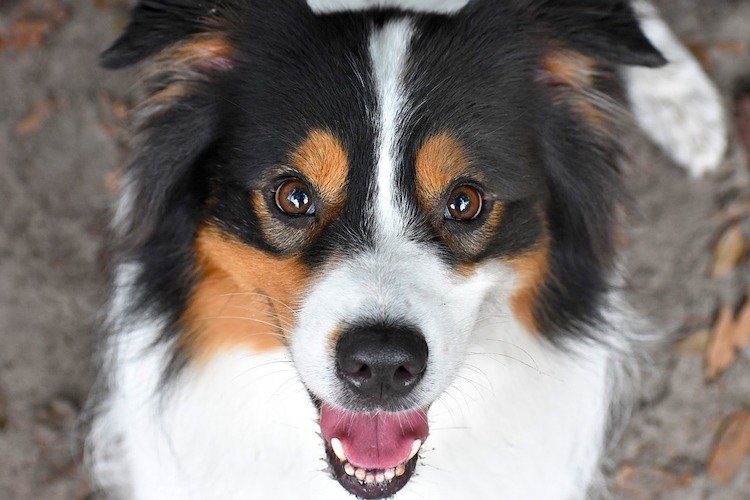DHPP, DHLPP, Da2PP: An Expert Guide to Your Dog’s Core Vaccine
DHPP and DHLPP (also known as Da2PP) are important vaccines that dogs need to help protect them against diseases. Here’s what you need to know.
This pet health content was written by a veterinarian, Dr. Debora Lichtenberg, VMD. It was last reviewed on August 8, 2024
If you have questions or concerns, call your vet, who is best equipped to ensure the health and well-being of your pet. This article is for informational purposes only and is not a substitute for professional medical advice, diagnosis, or treatment. See additional information.

- Understanding the DHLPP Vaccine
- Difference Between DHPP and DHLPP
- DHLPP Vaccine Schedule for Dogs
- D-H-L-P-P: Letter by Letter
- DHLPP Vaccine Schedule
- Which Dog Vaccines Are Absolutely Necessary?
- Antibody Testing
- What Does the DHPP or DHLPP Vaccine Cost?
- Vaccine Controversies
- Personalize Your Pet’s Vaccinations
- Final Thoughts on the DHPP or DHLPP Vaccine
- References

Don’t leave your pet’s safety to chance
Sign up for Petful recall alerts today.

Understanding the DHLPP Vaccine
The DHLPP vaccine is the “core” canine vaccine given to puppies and adult dogs to protect them from several serious and potentially fatal contagious canine viral diseases. A core vaccine is considered essential for all domestic dogs in the United States.
Key Points:
- Protects against several serious diseases
- Essential for all domestic dogs in the U.S.
- Given to both puppies and adult dogs
Difference Between DHPP and DHLPP
So what’s the difference between DHPP and DHLPP? The “L” in DHLPP stands for leptospirosis, which many veterinarians do not include in their routine vaccine — making it a DHPP vaccine. That’s why you may be more familiar with DHPP or the Da2PP vaccine. (“H” and “a2” are the same thing.) We’ll discuss all of these below.
For more information on whether to vaccinate your pet, check out this article on pet vaccinations.
DHLPP Vaccine Schedule for Dogs
Years ago, the DHLPP vaccine was given annually to all dogs. Today, after a series of puppy vaccinations, the DHLPP is generally given every 3 years or less.
Important Notes:
- Initially given as a series of puppy vaccinations
- Typically administered every 3 years in adult dogs
- Frequency may vary based on veterinary advice
Understanding the “Distemper Vaccine”
It was and still is commonly called “the distemper vaccine,” since the “D” in DHLPP stands for distemper, a common name for the canine virus properly called paramyxovirus.

D-H-L-P-P: Letter by Letter
Now let’s talk about what all these letters mean:

The D in DHLPP stands for the canine distemper virus (CDV), a dangerous viral disease in dogs caused by a paramyxovirus.
Distemper has nothing to do with the temperament of your dog. The name comes from the Middle English distemperen, which means the balance of the (bodily) humors is upset.
This could not be more true about canine distemper. The virus affects the respiratory, GI and neurologic systems as well as the skin and teeth.
Many people think this is a historical disease, meaning there are few to no cases anymore. This is not the case.
Although vaccination has helped control the disease, stray, wild and unvaccinated dogs remain a reservoir for it. Puppies born to unvaccinated mothers are at high risk.
As a veterinarian, I have seen several heartbreaking cases in my lifetime, so I do not consider this a historical disease at all.

The H in DHLPP stands for hepatitis, specifically infectious canine hepatitis (ICH) caused by an adenovirus.
Most DHPP vaccines in America contain an adenovirus-2 antigen for superior protection against hepatitis. The more appropriate name for this vaccine, then, should be Da2PP, but it’s still frequently called DHPP. The “H” basically equals “a2.”
(For science nerds: Hepatitis is actually caused by canine adenovirus type 1, CAV-1. But using CAV-1 in vaccines causes side effects. So CAV-2 is used in vaccines because it’s safer. CAV-2 is one of the causes of canine cough, but it also safely protects against the more serious adenovirus that causes hepatitis. Stipulating on the vaccine label that it is Da2PP means you’re getting the safe adenovirus vaccination.)
Infectious canine hepatitis can cause mild signs, like fever and anorexia, as well as serious illness and death. Again, very young dogs are most susceptible, and the disease is made worse if the dog has concurrent distemper or parvovirus infections.
Dogs with clinical ICH show high fever followed by anorexia, thirst and conjunctivitis. More serious cases cause abdominal pain, vomiting, blood clotting abnormalities and liver damage.

The L in DHLPP stands for leptospirosis, a bacteria transmitted to dogs (and people) through an infected animal’s urine. Infected standing water or bodies of water serve as a reservoir for the disease.
Infected dogs, rodents, farm animals and other wild animals can spread the disease, making this a problem in both cities and rural areas.
Leptospirosis causes liver and kidney damage. It can be treated but must be caught early in the disease process for the best prognosis. Unfortunately, the early symptoms can be vague, so treatment is often too late.
Leptospirosis may not be included in a dog’s basic vaccine protocol for several important reasons:
- There is a higher potential for vaccine reactions when leptospirosis is given in a combination vaccine (DHLPP). Many vets think it should be given separately.
- Vaccinating against leptospirosis is not necessarily needed in areas where the disease is extremely rare or if the dog has a sheltered lifestyle.
- The leptospirosis vaccine gives a short duration of immunity (less than 1 year). Since your dog receives the DHLPP or DHPP every 3 years or less, if lepto coverage is really important in an endemic area, it should be given at least once a year.

The first P in DHLPP stands for parainfluenza virus, a less serious (but highly contagious) viral disease of dogs.
It causes respiratory signs and is generally not deadly. According to Merck Animal Health, “The virus spreads rapidly in kennels or shelters where large numbers of dogs are kept together.”
Parainfluenza is not considered a core vaccine, but it is in the majority of the classic canine vaccines. Should it be included in the vaccine? That’s up for debate.

The second P in DHLPP stands for parvovirus, a devastating viral disease in dogs.
Discovered in the 1960s, this disease caused many dog deaths until a vaccine was formulated.
Parvo affects the GI tract, causing severe vomiting, diarrhea and dehydration. Puppies are affected most and require intense supportive veterinary care if they have any chance of survival.

DHLPP Vaccine Schedule
Years ago, the DHLPP vaccine was given annually to all dogs. Today, after a series of puppy vaccinations, the DHLPP is generally given every 3 years or less.
Important Notes:
- Initially given as a series of puppy vaccinations
- Typically administered every 3 years in adult dogs
- Frequency may vary based on veterinary advice
Which Dog Vaccines Are Absolutely Necessary?
The DHLPP or DHPP is the only canine vaccine considered essential for all dogs in the United States. That’s why it’s designated a “core” vaccine. Rabies is legally required.
The rest of the canine vaccines — like corona, Lyme disease, and leptospirosis, to name a few — are considered nonessential and should be given to dogs only when a complete risk assessment about the dog’s lifestyle has been made.
The American Animal Hospital Association (AAHA) publishes vaccine guidelines every few years and updates those recommendations regularly. Veterinary immunologists and researchers devise these recommendations and protocols based on scientific data to best protect the general population of dogs. You can find more details in their vaccine guidelines.
Standard Guidelines for the DHPP Vaccine
- Begin vaccinating puppies at 6–8 weeks of age.
- Administer sequential doses at an interval of 2–4 weeks until at least 16 weeks of age.
Why Do Puppies Need a Series of Vaccinations?
Most pups receive protection known as antibodies from their moms, so they are born protected against distemper, parvo, etc. These maternal antibodies, however, start to lessen and disappear sometime between 8 and 16 weeks.
Additional Points:
- The DHPP should be boosted again 1 year after the puppy vaccines and administered subsequently every 3 years or less frequently. The DHPP vaccine is probably protective in most cases for longer than 3 years.
- Puppies receive multiple vaccinations during this time to ensure the vaccine begins to give them protection as the maternal antibodies wane.
- By 16 weeks of age, the puppy has a reasonably mature immune system, and the vaccine gives them protection for the next year.
- If dogs receive their first vaccine at around 16 weeks, it is recommended to boost it in 2–4 weeks to ensure protection.
Recommended Vaccination Schedule for Puppies
The recommended vaccination schedule for puppies is crucial to ensure they are protected against various infectious diseases. Here is a typical DHLPP vaccination timeline:
- Starting at 6-8 Weeks:
- The first dose of the DHLPP vaccine is administered when the puppy is between 6 and 8 weeks old. This initial vaccination begins the process of building the puppy’s immunity against distemper, hepatitis, parvovirus, parainfluenza, and leptospirosis.
- Booster Shots:
- Subsequent booster shots are given at 2 to 4-week intervals until the puppy reaches at least 16 weeks of age. This schedule ensures that the puppy’s immune system is adequately stimulated to produce a strong and lasting response to the DHLPP vaccine.
- Annual Boosters:
- After completing the initial series of vaccinations, an annual booster shot is typically recommended for leptospirosis, while the core components (distemper, hepatitis, parvovirus, and parainfluenza) may be given every three years. This helps maintain immunity throughout the dog’s life.
Antibody Testing
Many people are concerned about over-vaccinating.
After a dog has received several DHPP or DHLPP vaccines, a blood test — commonly called a titer — can be performed to measure the levels of distemper, parvo, and adenovirus antibodies.
Considerations for Antibody Testing:
- Positive Titer: A positive antibody titer does not mean your dog is completely protected.
- Purpose: Measures the levels of specific antibodies in the blood.
- Limitations: Measuring an antibody level may not directly correlate to protection if the dog is exposed to the virus.

What Does the DHPP or DHLPP Vaccine Cost?
The cost is highly variable based on the individual hospital and the locality.
It is widely published that the DHPP or DHLPP vaccine should cost about $20, but this is likely on the low side. City practices may charge triple that amount. Some practices bundle vaccinations or provide “wellness” plans, so the price of a single DHLPP vaccine is not always clear.
Factors Influencing Cost:
- Location: Prices vary significantly between urban and rural areas.
- Hospital Pricing: Individual veterinary hospitals set their own prices.
- Bundles and Packages: Some practices offer bundled vaccinations or wellness plans.
Vaccinations given at clinics in pet stores may be more reasonably priced, but these places often up-sell unsuspecting pet lovers and might give unnecessary vaccinations — costing you more money in the long run.
Considerations for Pet Store Clinics:
- Lower Prices: May offer more competitive pricing.
- Upselling Risk: Potential for unnecessary vaccinations.
- Lack of Relationship: No ongoing relationship with a veterinarian for emergencies or medical advice.
The series of puppy vaccinations are more expensive, since we’re talking about giving 2–3 vaccinations over a few months. Some vets provide “puppy packages” that bundle vaccinations and services, such as stool checks, into a lump sum.

Vaccine Controversies
Vaccines, vaccine schedules, and which and how many vaccines to administer to pets are highly controversial. People hold strong opinions about vaccines and often defend their stance vehemently. Most vets listen to the concerns of clients and tailor a bespoke vaccine plan for every individual pet.
Balancing Vaccination:
- Past Over-Vaccination: We over-vaccinated our pets in the past before we knew better.
- Current Risks: The pendulum of public opinion can swing too far, leading to too many dogs going unvaccinated and diseases reemerging.
The Altruistic Side of Vaccination:
- Disease Control: Vaccinations not only protect individual dogs but also reduce the reservoir of the virus in the environment, leading to fewer cases of distemper and parvo.
- Herd Immunity: The majority of vaccinated dogs lessen the risk for unvaccinated or stray dogs.
In shelter situations or areas with a large stray population, outbreaks of these deadly viral diseases still occur.
Expert Insight: “The fewer animals that are getting the vaccine, the greater the likelihood that you’re going to have a firestorm if something that is that highly communicable comes along,” says Dr. Chris Brockett, DVM, owner of Saratoga Veterinary Hospital in Wilton, New York, and president of the state’s Veterinary Medical Society.
In this video, Dr. Clayton Greenway, DVM, explains more about the “contentious” nature of vaccines for pets:
Personalize Your Pet’s Vaccinations
When tailoring a vaccination program for your individual animal — specifically as it concerns how often to boost the DHLPP vaccine — consider the following questions:
Questions to Consider:
- Does your dog have close contact with many different dogs?
- Does your dog meet and play with other dogs?
- Does your dog stay in a boarding kennel?
- Does your dog go to doggy daycare?
- Does your dog go to a grooming facility?
- Does your dog participate in dog shows or agility?
- Does your dog have exposure to a shelter environment?
- Does your dog visit dog parks?
- Does your dog run free or hunt?
In addition to the above checklist, your vet will consider the age, health status, lifestyle, and previous vaccine history of your dog.
Case Study Examples:
Lady Gaga: Take, for example, Lady Gaga, a 10-year-old Toy Poodle living in a suburban neighborhood who is rarely off-leash. Gaga has been given a DHPP vaccine every 3 years for the past 10 years.
- Does she still need a booster every 3 years until she’s 16? Probably not.
Homer: Now let’s walk down the road and find Homer, the 9-year-old coonhound. Whoops! We can’t find Homer because he broke through his fence again and will be gone for several hours, as he often does. When he comes home, his human will reward him by taking him to the dog park.
- Should Homer continue to get a 3-year DHPP booster? Yes, I think so.
Final Thoughts on the DHPP or DHLPP Vaccine
Thanks to all of you for taking the time to think about vaccination and vaccinating appropriately.
Key Takeaways:
- Protection: Vaccines protect pets’ lives.
- Advancements: Modern veterinary medicine continues to improve vaccines and vaccine protocols.
Proper vaccination is essential for maintaining your dog’s health and preventing the spread of infectious diseases. By staying informed and working closely with your veterinarian, you can ensure your pet receives the best possible care.
Frequently Asked Questions (FAQ)
What is DHLPP vaccine for dogs?
The DHLPP vaccine for dogs is a core vaccination that protects against distemper, hepatitis, leptospirosis, parvovirus, and parainfluenza.
What is DHLPP?
DHLPP is a combination vaccine for dogs that protects against five serious diseases: distemper, hepatitis, leptospirosis, parvovirus, and parainfluenza.
References
- Ford, Richard B., DVM, DACVIM, DACVPM (Hon), et al. “AAHA Canine Vaccination Guidelines, Revised 2017.” American Animal Hospital Association. 2017. https://www.aaha.org/guidelines/canine_vaccination_guidelines.aspx.
- “Canine Parvovirus.” American Veterinary Medical Association. Feb. 2016. https://ebusiness.avma.org/files/productdownloads/LR_COM_ClientBroch_CanineParvo_022416.pdf.
- Creevy, Kate E., DVM, DACVIM. “Overview of Infectious Canine Hepatitis.” Merck Veterinary Manual. https://www.merckvetmanual.com/generalized-conditions/infectious-canine-hepatitis/overview-of-infectious-canine-hepatitis.
- Day, Michael J., BVMS (Hon), PhD. “Vaccination in the 21st Century: Theory vs. Practice.” London Vet Show. 2011.
- Ettinger, Stephen, DVM, DACVIM, and Edward C. Feldman, DVM, DACVIM. Textbook of Veterinary Internal Medicine, 7th ed. Saunders, 2010.
- “What is the DHLPP Vaccine?” Dogtopia. https://www.dogtopia.com/meet-the-experts/faq/what-is-the-dhlpp-vaccine/
- “DHPP Vaccine for Dogs.” MetroVetClinic. https://metrovetclinic.com/resources/dhpp-vaccine-dogs/
- “DHLPP Vaccine.” McAnimalHospital. https://www.mcanimalhospital.com/service-definitions/dhlpp-vaccine/








